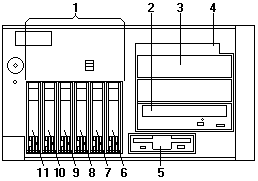
Installing Internal Drives
Different types of drives allow the system to read multiple types of media and store more data.
Several types of drives are available, such as:

Rack model

The server contains hardware that lets you replace a failed hard disk drive without turning off the server.
Therefore, you have the advantage of continuing to operate the system while a hard disk drive is removed or installed.
These drives are known as hot-swappable drives.
They are also referred to as hot-swap drives.
Each hot-swap drive that you plan to install must have a hot-swap-drive tray attached.
The drive must have a single connector attachment (SCA) connector.
Hot-swap-drive trays come with the hot-swap drives.
Note: The server's EMI integrity and cooling are both protected by having bays A and B covered or occupied.
When you install a drive, save the filler panel from the bay, in case you later remove
the drive and do not replace it with another.
SCSI Drives: Some drives have a special design called small computer system interface, or SCSI.
This design allows you to attach multiple drives to a single SCSI channel.
Notes
A 16-bit (wide) SCSI cable connects the SCSI HDD (hard disk drive) backplane to an integrated LVD SCSI controller
on the system board.
An additional 16-bit 2-drop SCSI cable is shipped disconnected inside the server.
It is folded and restrained with a cable clamp to the side of the power supply housing.
If you want to install a device in one of the non-hot-swap bays, you can either:
SCSI IDs: Each SCSI device that is connected to an individual channel of a SCSI controller needs a unique
identification (ID) so that the controller can identify the devices and ensure that different devices do not attempt to transfer data at the same time.
If you need to set IDs for SCSI devices, refer to the instructions that come with those devices.
The server automatically sets SCSI IDs for hot-swap hard disk drives.
The SCSI ID assigned to each hot-swap bay is shown on the server beside the bay and in the
illustrations in (above shown) 'Internal drive bays'.
The server uses the hard disk drive SCSI IDs to send status information to the indicator lights above each hot-swap bay.
The SCSI backplane in the server supports up to six hot-swap bays.
The processing sequence for SCSI devices proceeds from the lowest SCSI ID to the highest (0 to 5, then 8 to 15).
Termination (internal SCSI devices): SCSI buses must be terminated at each end.
The ends of the SCSI buses in the server are already terminated.
All the hot-swap drives in the server have automatic termination and the SCSI controller provides termination at the other end of the SCSI bus.
You must disable termination on any SCSI devices that you install in the non-hot-swap bays.
Refer to the information that come with the SCSI device for instructions about setting device jumpers or switches that control termination.
Please see the LEGAL - Trademark notice.
Feel free - send a  for any BUG on this page found - Thank you.
for any BUG on this page found - Thank you.